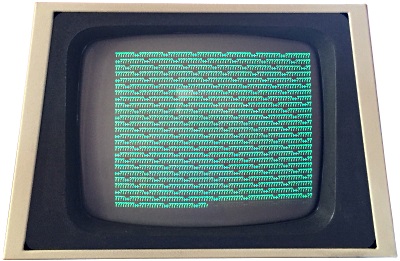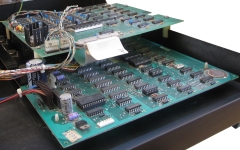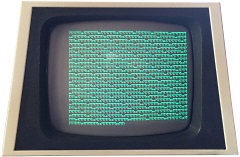|
 |
The Commodore PET
(Model : CBM 8096) |
Repairs - Peripheral Interface

6520 Peripheral Interface Adapter
The PET used two
MOS
Technology MCS6520
PIAs to interface with some of its peripherals, one was used
for the IEEE-488 interface and one for the keyboard interface,
as well as some other functions.
Keyboard Problem
My CBM 8032 started to fail very shortly after booting, the
system would start normally, displaying the expected "***
commodore basic 4.0 ***" and "ready" texts, and the cursor would
flash expectantly. After a few seconds, the number “2” would
appear on the Edit line and the cursor would start to flash at
higher than normal frequency. On other occasions, “2” appeared,
but not the cursor. After a few more seconds, the Edit line
would clear and the system had hung up.
To make access to the motherboard easier and to rule
out a problem with the 64kB mezzanine board, I removed the RAM
board. This just requires disconnecting the power leads and the
interface cable from the motherboard CPU socket and installing a
650 CPU in the motherboard. The system should then work as an
unexpanded 8032.
The two connectors on the front
left of the mezzanine board provide power to the board
and connect to keyed mating pin headers at the front and
rear left hand side of the motherboard.
The white
pull tab at the front of the board is the cable to the
CPU socket on the motherboard - the other end connects
to a pin header installed in the CPU socket. |
 |
At the same time as removing the RAM board, rather than
removing the CPU from the RAM board, I fitted a replacement CPU
in the motherboard socket. The symptoms were unchanged, so I
disconnected the keyboard - again, to no effect. I also replaced
my modified Editor
ROM with the original Commodore ROM, which also made no
difference to the problem.
At this stage,
Dave Curran helpfully pointed out that the 8032 uses two
6520 Peripheral Interface Adapters to control some of the I/O;
one dedicated to the IEEE-4888 interface, and one for the
keyboard and "speaker". The system should boot correctly, though
obviously without a working keyboard, speaker or IEEE-488
interface with both 6520s removed. I replaced the keyboard 6520
in board position UB12 with the IEEE-488 interface 6520 from
board position UB16.
Success ! - The system booted
correctly, did not lock up and had a working keyboard (and
speaker) again.
The next problem was sourcing a replacement 6520, they are
obsolete, but Dave advised that any 6520 or 6521 or 8520 should
work, unfortunately though, I did not have any of them.
(Although, as I discovered later, a Motorola MC68B21 that I
did have would have worked.)
I did find some Rockwell R6520APs from China on ebay and
ordered some for future use, but, needing a replacement 6520 in
a hurry so that I could continue testing the
petSD+ devices that I
had built before I shipped them, to avoid having to meet
Mouser UK's minimum order
value and to avoid the delivery time from the US, Dave let me
have one of his stock at cost.
That should have been the end of the matter, but
unfortunately, the machine developed an unrelated fault shortly
afterwards which again delayed shipment of the petSD+ orders.
More details soon . . . . . . . .
IEEE-488 Interface Problem
Recording this one as a separate problem is a bit of a cheat,
but I thought it worthwhile noting it as it could well have been
an actual fault if the other 8520 had failed.
With the system working again,
I decided to see how the fault on the 6520 would have
revealed itself if it had been installed in board
position UB16 for the IEEE-488 interface. This time, the
system booted fine and, as might have been expected,
operated without issue until the IEEE-488 interface was
used.
With my petSD+ connected though, issuing a
command to get the status of the device resulted in the
system displaying the screen shown - scrolling
screenfulls of gibberish. |
 |
| |
|
.
|